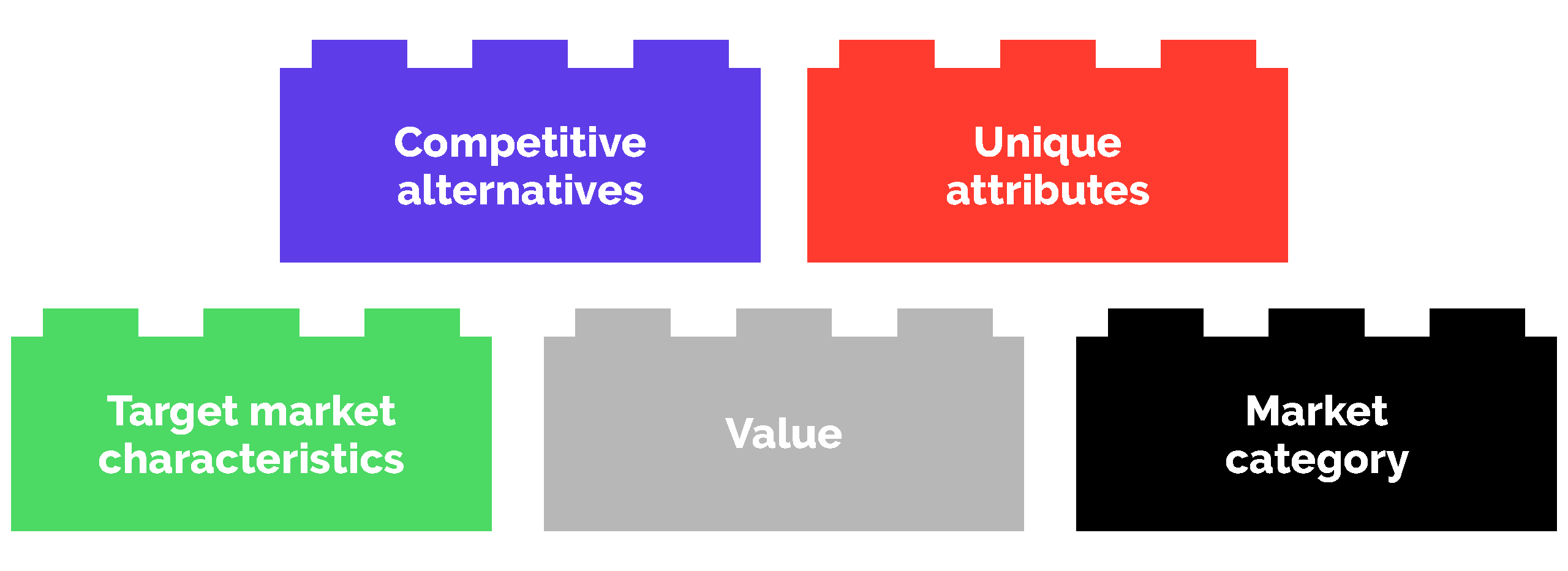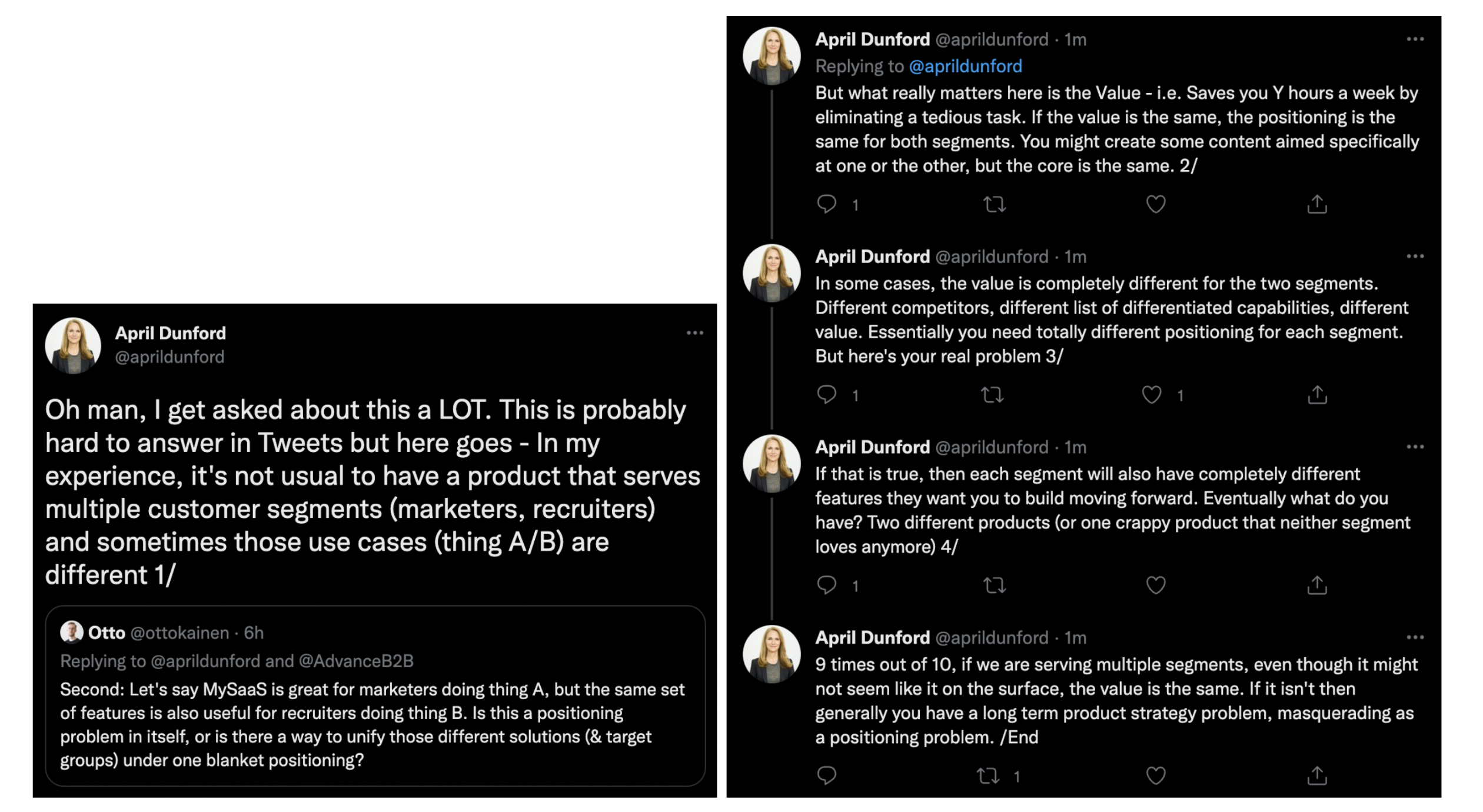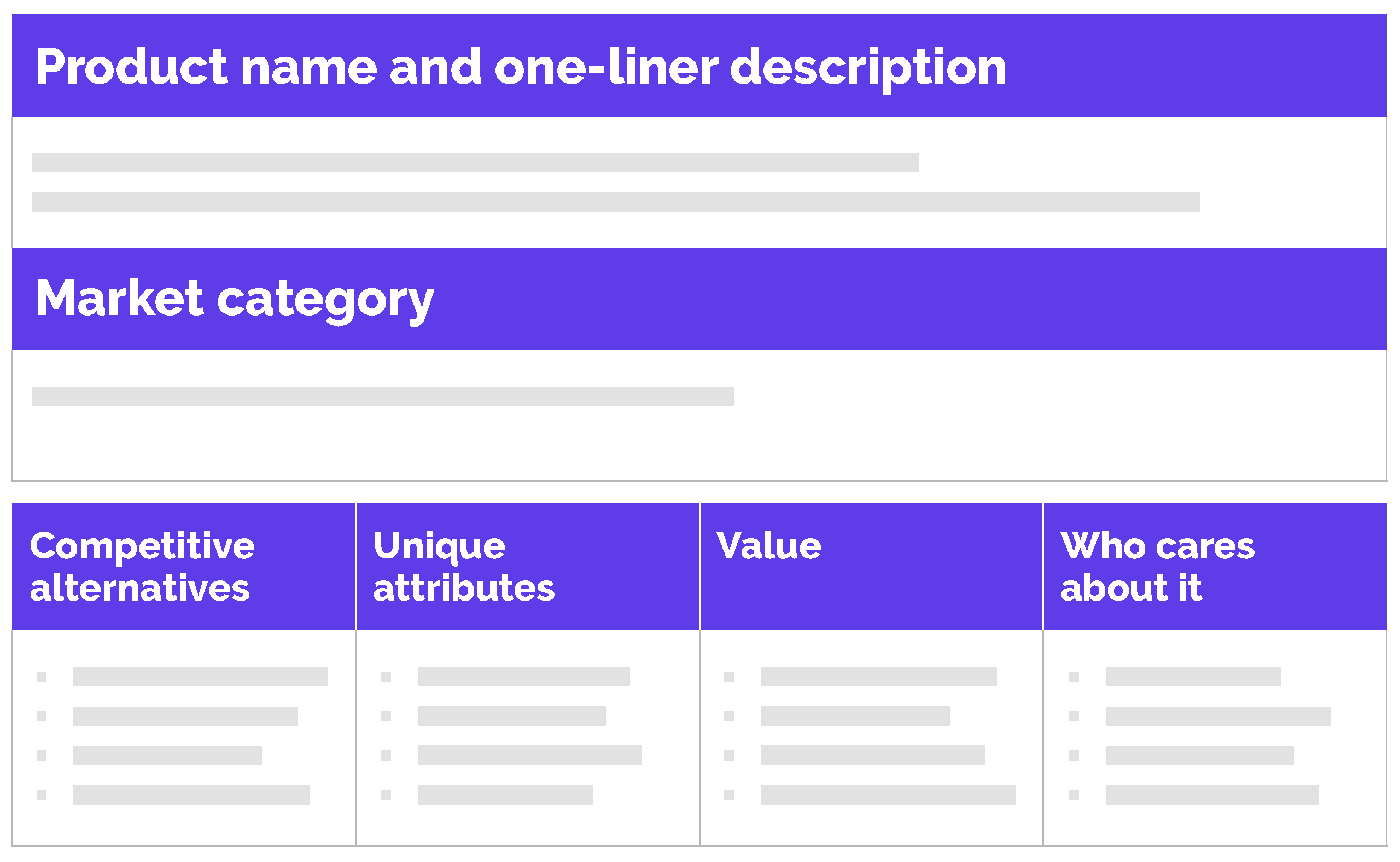It’s a SaaS-y world out there. You can rent a corner of the cloud to do just about anything for your business. But first, you need to find your best pick from the long list of vendors in [insert SaaS category].
But what if they all feel more or less the same? Let’s explore how your own SaaS product can avoid sliding into the obscure mess of a dozen identical tools making less-than-exhilarating promises.
The key? Positioning your SaaS in a way that resonates with a specific need state instead of with everyone looking for some help with marketing / sales / HR / accounting etc.
The case for SaaS positioning
I bet you’ve seen the martech landscape image that keeps getting more ridiculous each year (and that’s just the martech space). It has reached a point where the only sensible use is to make a point in blog posts like this one and move on.

I doubt that all of these CRM tools have a distinct positioning or unique value to offer.
What do you think are the odds of your SaaS product being selected from a sea of bright icons?
Quite slim, unless your positioning makes the others in your huge but tiny box look like they’re trying to be everything for everyone and probably failing at most of it.
Which is one of the reasons why every (SaaS) business should obsess over nailing its positioning.

"But hold on a sec..."
“... I’ve done my positioning homework when we first launched the product. Why the heck do it all over again?”
Yes, there’s always some positioning work behind a product, either conscious or less so. The big question is: what was that work based on?
Perhaps you bounced an idea off of your network, showed them an MVP of the solution, and filled out a positioning statement sheet with the obvious choices?
That’s all well and good in the beginning, when there isn’t much to base the positioning on. It’s a leap of faith you need to take to get going. But a lot happens in the months and years after that, and sticking to your initial idea about the positioning can go wrong in two important ways:
- After some time, you may find yourself stuck on the initial idea of the product, even though it has since developed into something entirely different. → Time to revisit the positioning!
- The market you originally went on to serve could have changed altogether. Technological disruptions wipe out needs for features all the time and make old-fashioned tools obsolete. → Time to revisit the positioning!
The good news?
When you do return to your product’s positioning later on, you’ll have much more to base it on. The customers you’ve attracted add a new and incredibly valuable view to positioning, because they are the ones who know first-hand what your product does well, and how it really helps them overcome obstacles and succeed in their jobs.
What do you know!
This Growth Hub Podcast episode talks about the exact same topic.
What we mean, when we talk about SaaS positioning
Positioning is, sadly, a case of easy-to-understand-but-hard-to-master.
You can’t grab your positioning and compare it with a picture printed from the customer’s head when they think about your product. It’s difficult to get a hold of, and that’s why so many SaaS businesses are reluctant to put in the work to improve it.
After all, positioning is just an idea, and you’ve got plenty of other ideas to worry about. Then again, this idea keeps the business running.
Hear April Dunford out on what is meant by positioning:
"Positioning is the act of deliberately defining how you are the best at something that a defined market cares a lot about."
Get her book and read it.
So just to make it clear:
Positioning IS NOT your value proposition or slogan or other piece of marketing content.
Positioning IS an input to all of that and more. It is how you set a context for your SaaS product and the unmatched value it delivers to a defined target market.
The building blocks of well-rounded SaaS positioning
We’ll continue along April’s thoughts, as she does a good job slicing and dicing positioning into 5 components:

- Competitive Alternatives – What would customers do or use if not your product? Remember that ‘a spreadsheet’ and ‘nothing’ and ‘hiring an intern’ may be equally relevant alternatives as Competitor X, whom you view as your main rival.
- Unique attributes – What differentiates your product or capabilities from your competitive alternatives? Not what you think or what should, but what truly differentiates you. If you aren’t sure, customers will tell you.
- Target market characteristics – Which customers care most about the value you’re able to deliver, and why them? What makes them love your product? Doubling down on this target group is essential to your positioning success.
- Value – What can you deliver to customers (with your unique attributes) that other alternatives can’t match? Demonstrable value signed off by customers is the goal, because anyone can claim to ‘save time’ or ‘make [thing] effortless’.
- Market category – Which category matches the value of your product? Getting this right helps customers connect the dots from problem to solution to value, sets their expectations, and makes it easier to buy the product.
Still with me?
We’ll get to finding the answers to these questions in a bit, but before that, let’s remind ourselves what it looks like…
When positioning fails (and a future of sluggish growth awaits)
Positioning is foundational to your business, and that’s why positioning problems can show up in many forms. Unless you have an alarm that goes off whenever it detects poor positioning, keep an eye on these almost certain signs 👀:
- Customers not knowing/using/caring about product features that you think are at the core of your solution
- Marketing and messaging that feels vague and lacking a sharp focus (often because the product lacks a sharp focus)
- Marketing and sales emphasizing different things (in the lack of a shared idea of a spearhead)
- Internal debate about messaging and what the product primarily does
- Advertising audiences not matching the actual customers you serve
And, every now and then, entertain the possibility that these common headaches could actually be symptoms of poor positioning:
- A high CAC that just won’t go down
- Low customer lifetime value or high churn
- Slow advertising performance
- A frequent need to update messaging
It is possible to grow to millions of ARR with a poorly defined positioning, but it’s gonna be an unnecessarily long road with slow punctures and shit you’d rather not deal with.
Think of positioning like the brand: as a growth multiplier. Get it wrong, and it will gnaw the results of everything you do in marketing and sales until fixed.
In the early stages of a SaaS company, it isn’t uncommon to mistake a positioning problem for a product-market fit problem. This may lead you to conclude that the market isn’t right, although you could just be going at it from the wrong angle.

Later on, after you’ve succeeded in growing the business with outbound sales, you may hit a wall trying to achieve the next growth stage. When you scale up and need to start attracting inbound leads or acquiring self-serve customers, you may notice that customers can’t make the connection between their problem and your solution anymore.
A gently pressuring “We’ll need more conversions and leads next month” directed at the marketing team won’t help. The root cause goes deeper than that.
You’ve got a positioning problem, and it can’t be solved by putting more effort into the same or even new tactics – time to revisit the positioning!
The failure to position your SaaS product inevitably leads to failures in marketing and sales. Try scaling to a one-in-a-million unicorn from that swamp. Try even growing from €1 million to €2 million in ARR.
A solid positioning is an essential remedy to pains with your most precious SaaS growth metrics, like CAC and LTV.
Okay, I get it. Time to revisit the positioning. So, where do I start?
Let’s outline the steps you can take to get it right.
A structured model for nailing your positioning
First, a word of encouragement:
Positioning work is really all about going back to the basics of why your business exists and how it helps customers achieve something meaningful.
I’d recommend you to build at least some kind of a process around the exercise and make it a recurring thing.
By the way, positioning touches pretty much the entire organization, especially management, marketing, sales, CS, and the product team. (What I wanted to say: it’s not marketing’s fault alone if you discover a positioning problem. They can only do so much about it.)
It’s good to try and assemble “a positioning team” from these different areas because it’ll bring up relevant perspectives and give the outcome the buy-in it deserves.

Step 1: Get to know the ones who love your product
You want to be doing customer research (here’s a great guide) whether you’re actively working on positioning or not.
For most SaaS products, the reality is that the same job could be done with sheets and text documents. It would just be tedious as hell.
Customers are the key to understanding what your product really is and does. They’ll have the answer to why they use your product instead of other competitive alternatives.
Ask your best customers at least these three questions to get to the juicy stuff:
- What problem does [product] solve for you?
- What does your world look like with/without [product]?
- What would you do if [product] didn’t exist?
Your goal should be to understand the connection between what is most painful to the customer in their work, and what your product can do better than other alternatives.
Sticking to your best, happiest customers will eventually bring up a pattern or two that shed light on what it is that makes the product so great for them. Repeat after me: customers are the key to understanding what your product really is and does.
Competitors are another source of positioning inspiration, but remember that their positioning could well be an even hotter mess than yours. So don’t blindly look at the one with the biggest market share and declare: That’s what we need to become. Rather, look at them to confirm where your uniqueness lies.
Your tasks on this step:
- Identify your best customers. ‘Best’ meaning the ones who get the most value out of your product and are willing to refer it to others.
- Interview them (with an at least semi-structured approach).
- List your (true) competitive alternatives based on the interviews.
Yesss, you’ve taken the first and most important step!
Step 2: Connect the dots between features and value
Your next task is to take what you learned from your best customers (about your value to them, their pains, and the competitive alternatives) to carve out a rough sketch of your positioning.
Do this by mapping the features that demonstrably benefit customers to value themes, i.e. the different types of value your product delivers. The exercise helps you build a coherent view of the parts that matter to your positioning – the things worth positioning for, and the things you actually can position for.
Go from feature to benefit to value.
.png?width=2560&name=ADVB2B-SaaS_Positioning-1%20(1).png)
After you’ve created the full list of loved-by-customers features, you’ll see that some features naturally fall into the same value theme.
Sometimes it’s difficult to resist the temptation of calling every small thing in your product a game-changing feature.
Hey @aprildunford, how might one avoid the feature frenzy and prevent that from clouding up the positioning focus?


Thanks!
So, based on customer research, you move from features to a value-based focus.
Your tasks on this step:
- Identify your (truly) unique attributes and features, compared to the competitive alternatives that came up in customer interviews. What does your product do that those other alternatives can’t achieve?
- Map those features and the related benefits to value themes (max. 3 themes)
You’ve now turned the painkillers and vitamins of your product into customer-termed benefits and value. But hold your horses! The work is not done yet.
Step 3: Make your differentiated value strategic
In the previous step, you identified your product’s differentiated value. The situation looks something like this, where ‘points of difference’ represents the overlap between your product’s unique attributes and the customer pains alleviated by the benefits of those features.

We use this exercise regularly when working on our customers’ growth marketing strategies.
This differentiated value is the foundation of your positioning, but there are a couple of ways to put that to work.
Let’s take up the goal of positioning as a reminder: to deliberately define how you are the best at something that a defined market cares a lot about.
There are three styles you can go about achieving this; (1) aiming to win a market that already exists, (2) aiming to win a subsegment of the existing market, or (3) aiming to create and win an entirely new market. Come again?
- Winning an existing market
If your product was a CRM software, this approach would put you head-to-head with overall market leaders like Salesforce, SAP, Oracle, and Microsoft. Your goal is to beat them in their own game. Wrestling established players takes effort, because the only way to win is basically doing the same things, just better.
- Winning a subsegment of an existing market
By narrowing down your focus, you could for instance try to be the no. 1 CRM for law firms with fewer than 50 employees. In most cases, this approach is definitely more doable than winning the overall market. Just be careful to choose the right subsegment or pond to go all big fish in – it should reflect the differentiated value that you’re already delivering.
- Creating and winning a new market
Perhaps your product is kind of like a CRM, but also nothing like those old-fashioned CRM relics. And nothing like anything else, either. Category creation is a massive challenge, because first you need to convince the buyers that your category is even a thing. If you manage to pull it off, the pile of rewards will include a sustainable first-mover advantage.
What are we? You may find that this simple question isn’t too easy to answer unequivocally. But, it is one you should get to the bottom of, when choosing your positioning approach.
And what if your SaaS product is fit for serving multiple target markets? Here’s a few tweets’ worth of wisdom to reflect on. (Thanks April!)

Your tasks on this step:
- Make sure you can articulate your differentiated value in terms of features and benefits that the customer cares about.
- Select a positioning strategy (to win: an existing market, a subsegment of an existing market, or a category that you created yourself).
- If it all seems like a mess, challenge your product strategy and see if you should actually diverge products for different target markets or use cases.
Don’t despair – we’re getting close to the end here.
Step 4: Turn your positioning into something real
Positioning becomes useful once it can be applied across the company.
Once you’ve found your differentiated value and thought about your overall positioning strategy, it’s time to make the sparks fly. You’ll need something handy to help the organization implement that sweet position essence.
We’d recommend you to use something like April Dunford’s (isn’t any of this stuff original?) positioning canvas for documenting your findings. It looks something like this:

When you’ve got this nailed down, you’re ready to start shifting your focus in messaging, sales pitches, pricing, product roadmap and so on. As you remember, positioning touches all of the organization somehow, and it’s decisive to your success to get it through.
A positioning statement is another common way to put things into a more practical form, but only use it if you acknowledge its flaws. If you took all the steps thus far, your statement should be more a useful thing than a caricature example for the marketing fails yearbook.
From here on, you’re kind of on your own (unless you ask for help, that is). You need to take ownership of that diamond-cut positioning. You want it to guide decisions on product, sales, marketing, and more. It’s going to make your journey to the next MRR or ARR goal much smoother.
Your tasks on this step:
- Document the positioning in a usable format like the positioning canvas.
- Use your discoveries to guide strategy and tactical decisions related to messaging and marketing content, sales, product strategy, pricing, customer success, and so on.
DO NOT conclude that you’re done now, because you will still need to…
Step 5: Adapt & iterate as the market (or your product) evolves
It’s no news to you that things tend to change fast, especially in the tech-intensive SaaS field.
So, as important as putting your heads down to do some positioning work now, is to revisit the positioning in the future. Check-in every 6-12 months to review if your idea still applies to the current market and your capabilities.
The core of your positioning should be stable enough to survive through changes, but fluid enough for necessary recalibration. Not every little shift calls for a positioning update, though.
Here are a few clues saying you may want to revisit even before your next scheduled review:
- A direct competitor launched a feature that previously only your product had in it (and it seems that they may have made it superior while at it)
- A market change threatens to render a core feature or technology of your product useless in the future
- A significant drop in new customer acquisition for no apparent reason
- A significant hike in churn rate for no apparent reason
- Major privacy-related or regulatory plot twists that limit how customers can use your product
A lot can happen.
Your tasks on this step:
- Book the next check-up(s) with the positioning team.
- Keep an eye on your growth metrics, continue to do customer research, and follow what’s going on in your category and the ones close to it.
- Be prepared to pivot when necessary.
The wins of great positioning - what’s in it for you?
Ultimately, positioning is focus. And why is focus so important?
It leads to:
- Marketing and sales that address the right pains
- Better fit prospects and customers
- Easier and cheaper sales
- Better fit projects and partnerships
- Higher customer satisfaction
- Higher LTV and profitability, lower churn
Desirable things for any SaaS business.
A foggy positioning is the mother of all SaaS growth bottlenecks. Keep getting unamusing reports of ad performance, closing rates, retention, or a number of other key growth indicators?
Remember that you may be dealing with a positioning problem, and that no amount of money, processes, or staff changes is going to magically fix that.
Last piece of advice
These are my final words for you, SaaS founder, sales lead, CMO, or anyone dedicated to the current product and/or its origins:
Your shot at the growth-feeding positioning will fall short unless you internalize a readiness to be painfully honest about what’s deeply unique about your offering and value to customers – and what isn’t.
None of your darlings or the shiny new things that competitors seem to be doing should be so preciously obsessive that they end up fogging the clarity you’re striving for.
Kill them and focus on what matters:
A clear market position at the sweet spot of what your product does best, and what your customers need and value most.



/What%20every%20buying%20committee%20member%20needs%20to%20say%20yes/what-every-buying-committee-member-needs-to-say-yes.jpg?width=352&name=what-every-buying-committee-member-needs-to-say-yes.jpg)
